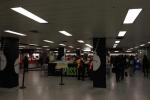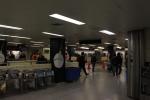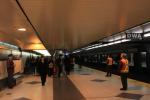Updated November 27 at 10:00 am:
A section has been added at the end of this post with photographs of Bloor-Yonge station showing the crowd control measures.
During the AM peak, the TTC is experimenting with crowd control measures at Bloor Station, southbound with the intention of getting more trains down the line and increasing its peak capacity.
Media reports last week did not fully describe what is happening, and for the benefit of those who do not use the station in the morning rush, here is a short description.
- The existing station before the change:
- The southbound platform is double-width thanks to an enlargement of the station many years ago during construction of a new office tower. There is the original platform plus a passageway of almost equal width separated from the main part of the platform by pillars, and at the north end, a wall with several openings.
- To the west of the southbound platform is the concourse linking the Yonge and Bloor lines, and two sets of stairs and escalators down to the BD level (Yonge Station). The set closer to the Yonge subway platform tends to be the more heavily used.
- Passengers coming from the BD line would tend to congregate at the north end of the Bloor Station platform because (a) that’s where they came from the BD subway, and (b) many passengers want to go to the north end exits at College, Queen and King stations.
- Yonge trains arriving southbound tended to be most crowded at the north end with passengers intending to transfer to the BD line.
- Following the change:
- In the west mezzanine, riders coming up the stairway closest to the Bloor Station platform meet a temporary set of barriers directing them into the passage along the wall side of the platform. They do not actually get on the platform and cannot board trains until they are over two car-lengths down the platform. If they really want a north end car, they must double back at that point.
- Riders coming up the far stairway have the option of joining the flow into the southbound passageway, or swinging to the north either to leave via the station exit, or attempt an end-run onto the north end of the platform.
- Riders leaving southbound trains are directed to walk north on the main part of the platform and then into the concourse. This divides the traffic from Yonge-to-Bloor transferees who use the main part of the platform from the Bloor-to-Yonge transferees who use the passageway.
- TTC staff are positioned at critical locations to ensure that people actually follow the correct path so that ideal flows are maintained.
- TTC staff are at each of the train door positions to ensure passengers can first get out of the trains, and then to regulate boarding so that when the train is ready to leave (full or with another train nearby) passengers don’t rush the doors and try to jam on at the last moment.
For the first few days, it took time for passengers to get used to the new arrangements, and many are still seeing this setup for the first time. From talks with TTC staff at the station, I learned that the confusion is falling off, and I saw few problems myself.
Although the “doormen” were the feature most talked-about when this scheme was announced, the primary benefit comes from the separation of flow using the platform and adjacent passageway. Forcing the passengers from BD to move down to the southern part of the platform also makes for much better distribution of train loads. Indeed, it was odd to see trains leaving Bloor southbound with comparatively empty cars at the north end, but with nobody left behind on the platform.
During the height of the peak, starting at about 8 am, there are four “gap trains” originating from Davisville southbound that are slotted into the service where they will fit. These run express to Bloor and arrive empty. They require no offloading time, and can empty the platform of waiting passengers quickly. If one of these arrives every 4th train or so, any backlog of waiting passengers is scooped up and the platform does not get a chance to become badly crowded unless there is a delay in service.
The dwell time, measured as door opening to door closing, for trains ranges from roughly 30 to 45 seconds with the majority being under 40. The TTC has been able to push more service through Bloor Station during the 8-to-9 am period. On a 2’20” scheduled headway, one would expect 25-26 trains, but they have managed as high as 29. This is very close to the design minimum of 2’00” for the Yonge subway’s signal system. Every extra train, especially the empty ones, represents up to 1,200 more passengers on the line. In practice, none of the extras left completely filled because waiting to load up would have delayed trains behind them. This situation will vary especially on days when there is a gap in service, and holding the gap train at Bloor is operationally feasible.
The TTC has not yet decided on whether to continue the experiment indefinitely, or to suspend it pending review after the trial period, although comment I have heard were very favourable.
It will be important to see this in operation once we have real winter weather and the inevitable jump in ridership comes with the first snowfall.
A note about staffing:
This operation is quite labour intensive, necessarily, but the marginal costs are low.
The “doormen” are all staff who are on “modified duties” due to illness or injury which prevents them from working their normal jobs. They are paid and assigned, as needed, to a variety of functions, often as extra fare collectors. In a pinch, if the TTC was short of staff as “doormen”, some could be dropped at the south end of Bloor Station where passenger congestion is rarely an issue.
The Special Constables are those normally assigned to Bloor-Yonge Station.
The large contingent of supervisors will be cut back next week as clearly this many people are not needed to manage the operation.
There will be an ongoing cost for a small number of resident staff for part of their work day. However, this is considerably cheaper than the capital and maintenance costs associated with implementing some sort of barrier system that would be in place and working all the time.
Moreover, having staff provides the ability to cajole riders into the desired behaviour in a way technology never can. Some people whose mind is set on getting from “A” to “B” via their accustomed route may grumble, but if met by friendly staff (a description I would apply to those I have seen working at Bloor), they will usually co-operate.
This is a work in progress, and it bears watching as an example of the TTC trying to improve the quality of its service and maintain a good relationship with its riders.
Photos of Bloor-Yonge Station
On the morning of November 27, I dropped by Bloor-Yonge to photograph the operation before the height of the peak period in order to get some clear views of the layout.
When I started photographing, I was immediately challenged by a Supervisor who asked what I was doing, and I replied rather testily that I didn’t neet a permit for “personal use” photography according to TTC Bylaw 1. Another photographer was also in the station and he had the same experience. My apologies to the Supervisor with whom I was rather short as it was early and I had not yet had breakfast. Conversations with many other TTC staff were quite congenial, probably because most of them had seen me the day before chatting with various TTC officials. However, it is annoying that the provisions of the bylaw are not clearly understood, and I know amateur photographers are still hassled about this.
The West Concourse
This is the area with two sets of stairs and escalators linking the Yonge Station on the Bloor line below to Bloor Station.
This view is taken with the west escalator immediately to the left looking east toward the southbound platform. In the immediate foreground is the east escalator. Passengers coming up the escalators are directed to the right and later into a passageway dedicated for shifting riders to the south end of the southbound platform (see below).
This shows the west concourse closer to the southbound platform including the temporary barriers to send transferring passengers down the side passageway.
This view looks south in the west concourse showing the barrier and in the distance the passageway taking transfer passengers from BD to the southern part of the platform. Note that when a gap train is coming into the station, it will be empty, and there is no need to segregate the flows. Before the gap train arrives, staff will open the barrier so that BD passengers can walk directly to the north end of the southbound platform.
This view looks from the southbound platform into the west concourse showing how passengers leaving southbound trains are directed to the north end of the concourse and around the area where BD transfer passengers stream up from Yonge Station.
Southbound Platform
This view looks north showing the side passage through which BD transfer passengers flow onto the platform as well as the main part of the platform. Here, a train is loading, but we are between arrivals on the BD line (also it was early in the peak period) and the side passage is clear.
In this view, transfer passengers from BD are arriving to a platform that has just been cleared by a southbound train. These passengers will mainly continue south, assisted by gentle encouragement from TTC staff, but some will double back to stand where they can board the northernmost cars of the next train.
This view shows the side passage with BD passengers arriving and moving toward the south end of the platform.
This view is the southbound platform, just to the left of the previous photo. The TTC staff will cut off passenger flow into the train when it is about to be despatched. The decision on when to send a train out is balanced between the load it already has and whether the next train is immediately north of the station. This can be seen easily by checking the “Next Train” displays on the video monitors.
Again, the southbound platform after the train has picked up all waiting passengers. In this case, the demand at the station has not built up to the point where the train is full and it isn’t necessary for the “platform attendants” to hold back passengers for the next train.
Finally, I must say that Amex’s Station Domination campaign does nothing for the look of Bloor-Yonge Station. Why do we spend a fortune on the appearance of stations only to have them turned into, effectively, walls for corporate grafitti? The design of this campaign is so visually busy (not to mention unattractive) that the real signage, including the name of the station, is hard to find. Anyone watching for a yellow station might completely miss it.
I don’t have an Amex card and don’t plan to get one especially if this is what passes in their mind for a contribution to a major public space.










Are we civilized in this city? Do we also need constables to walk from car to car to tell people not to block doorways even though it says it right in their face? Nobody can read English in this city?
LikeLike
“Our subway system is really embarrassing; look at the signs for directions, they are so hard to understand!”
Well, to their credit, the sign at Bloor Station will helpfully point you in the right direction to find Roy’s Square.
Steve: For those who are unfamiliar with the area, Roy’s Square was the laneway behind several small stores on the southeast corner of Yonge and Bloor. These stores have been demolished and Roy’s Square is little more than a walkway through a construction site.
LikeLike
Steve: I believe the reason that the easternmost escalator always runs up is that the TTC doesn’t want the heavy northbound to Bloor transfer traffic to be pushed out into a small space at the very far end of the platform. There are better options for passengers arriving at the bottom of the currently “down” escalator, although “better” is a relative term here.
But that just results in the easternmost portion of the platform being mostly empty, since very few people will walk the extra distance to catch the up escalator. If those people were intercepted at the other elevator first, people coming down the easternmost escalator would be better able to file west along the platform, without colliding into the mob of transfer traffic moving in the other direction.
Steve: They have to take into account situations where there is a delay in service and the area at the bottom of the escalator is completely plugged. A good chunk of this space was eaten up by the elevator installed there a few years back.
LikeLike
“Roy’s Square was the laneway behind several small stores on the southeast corner of Yonge and Bloor. These stores have been demolished and Roy’s Square is little more than a walkway through a construction site.”
Anybody remember WHY it was named Roy’s Square? Why, to honour the great Canadian Roy Rogers! (I know, he’s not Canadian, and that’s my point), who was promoting a chain of fast-food chicken outlets bearing his name in the 70’s. Needless to say, they didn’t last long, and the one on Bloor just west Of Roy’s Square was converted into a Harveys.
LikeLike
The platform programme will be permanent, according to the Star.
The half-billion-dollar rebuild of Yonge/Bloor is also mentioned. No mention of the DRL, though.
Steve: At least TTC management now acknowledge that the big rebuild is a complex and expensive project.
LikeLike
Steve, just a quick note here..
(Just so everyone can understand my directions here, I’ll let you all know that I’m legally blind and use a white cane.)
I avoid Y&B at all costs when I can, except when heading to the CNIB, then I board the train at Kipling, I get on the lead car eastbound, (east end of the platform) that usually lines me up with the up Esclator to the northbound platform on the Yonge line, I then walk (keeping to the Left against the wall, I walk to the south end of the Yonge platform, this lines me up with the up Esclator to the bus platform at Davisville.)
Coming back home, I walk to just about the north end of the southbound platform at Davisville, (I look for a metal plate on the platform as my landmark) that lines me up with the exit at Yonge, for the Bloor Trains, I hate the Bloor platform at rush hour, I try to move to the west end of the platform, but the crowds sometimes are just too much for me to get through, so I get on where I can, choosing to exit and walk to the east end of the platform at either High Park or Kipling, as both of these stations have my home bus route serving them. (It has horrible service, so I choose which I’m going to get off at, depending on the time, as I have the schedule memorized for both stations.)
I use my rider efficiency guide extensivly (I’ve worn out 2 copies of it already) to get where I need to go, I also have taught some of it to my blind friends, and it helps us out a lot.
LikeLike
I’m not sure if this is the right place, but I noticed in this document:
Click to access TYSSE%20Construction%20Information%20Session%20Presentation%20Final%20Update%20120409.pdf
that there are to be platform doors in all of the new stations on the Spadina extension.
Steve: The stations have provision for platform doors, but this will require that the YUS fleet be entirely TR trains. The TTC has not yet ordered enough trains to achieve this, although may do so part way through 2010.
LikeLike